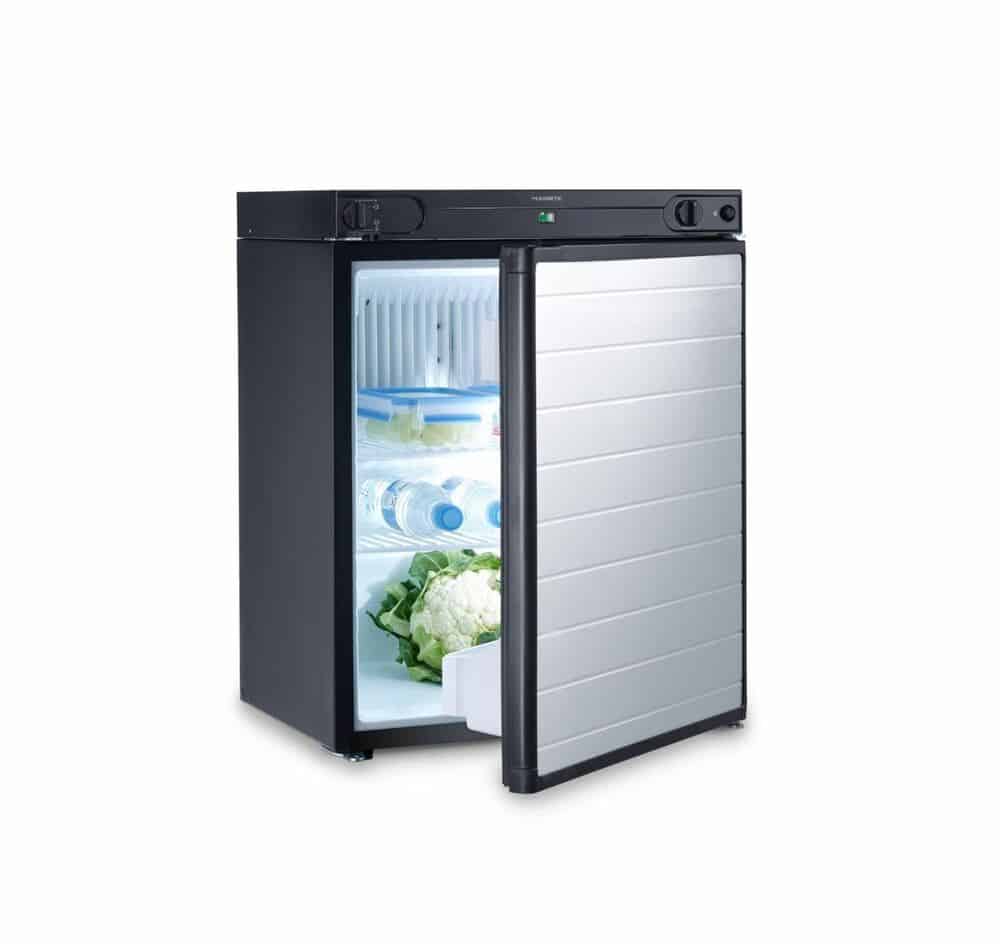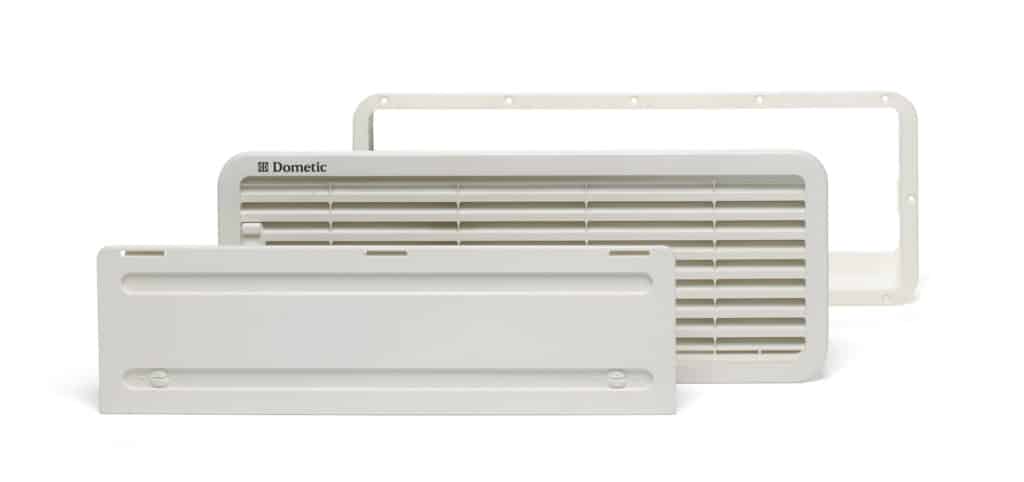Your fridge may struggle to keep your food cool when the temperature gets warmer outside. While you might think it could be a faulty cooling unit or a power board issue, you should also check to see if your fridge has proper ventilation.
The best way to set up campervan fridge ventilation depends on the design of your vehicle and the type of campervan fridge. However, the problem with most fridges is the lack of ventilation behind the unit. Consider installing an additional fan or adding air vents to help cool the unit down.
Since there are different types of campervan fridges, there are multiple ways to set up a campervan fridge for maximum ventilation. If you’d like a thorough guide that expands on the different fridge types and ventilation methods, keep reading and choose the setup that works best for you and your campervan.
About Campervan Fridges

It is crucial to choose the best type of campervan fridge for your campervan if you plan on storing food and drinks. Fridges work by circulating refrigerant through a network of pipes. Heat is drawn from the storage compartment in the fridge when refrigerant changes from a liquid chemical to a vapor. The vapor then cools and becomes a liquid, into a continuous cycle of heating and cooling.
The size of the campervan fridge differs for each van. If you are fitting a fridge for a sprinter van, you will be able to install a larger fridge than someone camping in a smaller vehicle. The larger the size of the fridge, the more power the unit is going to use, and the more ventilation it will need to keep the contents in the fridge cool.
There are three different kinds of fridges available on the market for campervans, and they all have their advantages and disadvantages. There are different ways to ventilate the fridge, depending on the type of fridge. But not only does the fridge you ultimately choose depend on the power supply, but it also depends on how you plan on using your campervan.
Proper Ventilation of Compressor Fridges
Compressor fridges utilize a compressor to circulate the refrigerant through the machine. External ventilation is usually not required for this type of fridge because compressor fridges use a fan to draw air across the condenser unit.

These fridges are powered by the 12-volt system or by using an adapter through the main electrical system installed in your campervan. The key to using a compressor fridge is to ensure the installation encourages good ventilation and airflow through the cooling unit’s condenser coils.
While most fridges have one cooling fan, you can retrofit another cooling fan to improve airflow- removing warm air from the back of the fridge and bringing air into the compartment. It’s important to be cautious when buying a secondary fan to install as it can be very noisy. More cooling will reduce the time it takes the fridge to settle to the cool temperature and save power overall.
External ventilation is usually unnecessary because not as much heat is created as other campervan fridge types. If you install a compressor fridge into a compartment, ensure there is enough airflow on all sides. Remember to clean off the built-up dust on the condenser because it makes it more difficult for air to flow properly. It is important to maintain a clean condenser with proper ventilation for an efficient fridge.
Proper Ventilation of Absorption Fridges
Absorption fridges use a source of heat to provide energy for the cooling system. These fridges are also alternatively known as “three-way,” as they use power from three different sources:
- Gas
- 12B DC power with a separate battery or solar-powered
- 230V main electric
This fridge type is an excellent alternative option to compressor fridges, especially if you plan on camping off-grid or away from any campground electricity. However, the disadvantage of this absorption type of fridge is that it requires proper leveling to work correctly and requires additional external ventilation through the sidewall of your campervan.
Specific vents need to be installed to extract any heat or fumes generated by the fridge operating on gas. These special vents are installed on the campervan side so that these gases can be exhausted externally. The best place for proper ventilation is around the fridge’s top surface where heat builds up, so when fitting a vent, always choose a larger size to allow air into the compressor component in the absorption fridge.
It is important to note the bottom of the top vent must be equal to or above the fridge’s top to ensure air moving up through the vents will flow through the cooling unit. If there are installations where it is not possible due to campervan restrictions, it might not perform very well in hot weather.
While absorption fridges typically do not need a cooling fan (except recommended in tropical weather and hotter temperatures), having a cooling fan can reduce the fridge’s temperature. You can install a small fan around the fridge’s top area to blow directly across the cooling fins. The fan’s purpose is to improve the air draft, not blow air directly onto the cooling unit. The vent fan can optimize the fridge’s cooling capacity by up to 50%.
Proper Ventilation of Thermoelectric Cool Boxes
Thermoelectric cool boxes are excellent if you are building a campervan on a budget. It works by using electricity to remove warm air within the coolbox, and it’s not as sophisticated as the other fridge options. Cool boxes are usually smaller than fridges and struggle to work efficiently in warmer weather.
Thermoelectric cool boxes require good ventilation all around the unit while it is in your campervan. If installed in a compartment, it requires airflow at all sides and the top to avoid blocking the fan. To make the thermoelectric cool box cooler for a longer time, keep the air conditioner running or install a roof vent like this Fan-Tastic Vent RV Roof Fan to pull hot air out from the campervan to maintain the perfect temperature.
Bad Ventilation for Campervan Fridges
Since venting of a campervan fridge is designed to expel warm air from the cooling unit and create airflow to remove heat efficiently. While the best way to ventilate a campervan fridge differs depending on the type of fridge, the following are some bad venting issues that can occur.
If there is a space cavity on top of the fridge, so-called “dead air space,” this area can cause warm air to increase, reducing airflow. Also, if the area between the cooling unit and the wall is greater than 1 inch (2.54 cm), it can allow air to bypass the cooling unit and not cool properly. The cooler air bypassing the cooling unit does not extract heat from the fridge coils and weakens the airflow by cooling the warmer air above.
Poor venting can cause overheating issues and damage the overall unit, so make sure to adjust accordingly to avoid these bad venting installations!
Final Thoughts
Campervan fridges are a convenient addition and are among the most useful appliances to bring with you on a camping trip. By improving their performance and optimizing efficiency, you can save electricity and ensure your food and drinks are properly cooled.
It’s important to understand the differences between campervan fridges and the type of ventilation required for each type. Since the type of ventilation needed for campervan fridges differs on the type of fridge you have or are planning to buy, it is crucial to understand the basics of ventilation to utilize your fridge.
But remember, call in a professional to consult on your campervan build if you need more help with ventilation best practices or fridge issues.
